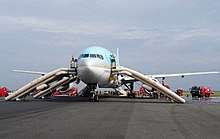Korean Air Flight 2708
On 27 May 2016, a Boeing 777-300 of Korean Air, operating as Korean Air Flight 2708[1] from Haneda Airport in Tokyo to Seoul's Gimpo International Airport, was accelerating for take off when its left engine suffered an uncontained failure and a substantial fire ensued. The crew aborted the take-off, and after the aircraft came to a stop the fire was extinguished by the airport emergency services. All 319 passengers and crew were evacuated; 12 occupants were injured.[2][3]
 HL7534, the aircraft involved in the accident, after evacuation | |
| Accident | |
|---|---|
| Date | 27 May 2016 |
| Summary | Uncontained engine failure on take-off |
| Site | Haneda Airport, Tokyo, Japan |
| Aircraft | |
| Aircraft type | Boeing 777-3B5 |
| Operator | Korean Air |
| IATA flight No. | KE2708 |
| ICAO flight No. | KAL2708 |
| Call sign | Korean Air 2708 |
| Registration | HL7534 |
| Flight origin | Haneda Airport, Tokyo, Japan |
| Destination | Gimpo Airport, Seoul, South Korea |
| Occupants | 319 |
| Passengers | 302 |
| Crew | 17 |
| Fatalities | 0 |
| Injuries | 12 |
| Survivors | 319 (all) |
Aircraft and crew
_(4358768879).jpg)
The aircraft operating Flight 2708 was a Boeing 777-3B5[lower-alpha 1] equipped with two Pratt & Whitney PW4000 engines, registered HL7534, serial number 27950. The 120th Boeing 777 produced, it first flew on 4 February 1998, and was delivered new to Korean Air on 28 December 1999.[4]
The captain, 49, had logged a total of 10,410 flight hours, including 3,205 hours on the Boeing 777. The first officer, 41, had 5,788 hours with 2,531 of them on the Boeing 777.[5]:10–11
Accident
As the aircraft was taking off from Runway 34R at Tokyo Haneda, the pilots heard a loud bang coming from the left. The pilots aborted the takeoff and the aircraft came to a stop, whereupon an evacuation commenced. All the occupants escaped, but 12 passengers were injured and were taken to a hospital near the airport. Incoming flights were diverted to Tokyo's Narita International Airport and to Osaka. The airport firefighters quickly extinguished the fire. The aircraft reportedly travelled 700 metres down the runway before coming to a stop, with engine-parts scattered 600 metres from the point at which the aircraft began accelerating and tire-marks 700 metres from that point.[6]
Investigation
The Japan Transport Safety Board, Korea Aviation Accident Investigation Board, and the United States National Transportation Safety Board all investigated the accident, with assistance from experts in South Korea and the United States. On 30 May 2016, investigators revealed that the LP turbine blades on the left (number one) Pratt & Whitney PW4098 engine had "shattered", with fragments piercing the engine cover, with fragments subsequently found on the runway. The engine's HP turbine blades and HP compressor were intact and free of abnormalities, and investigators found no evidence of a bird strike.[7] As of June 2016, the investigation into the cause of the accident was still ongoing.[8]
The aircraft was repaired and returned to service with Korean Air on 3 June 2016.[9]
A later JTSB investigative report, released on 26 July 2018, discussed a significant number of problems related to the failure and the response of the crew and passengers to it. These included poor maintenance standards that overlooked a crack growing in the LP turbine disc in the engine created by metal fatigue that eventually failed, the failure of the crew to locate the list of emergency procedures for use in such an emergency, beginning evacuation of the aircraft whilst the engines were still turning meaning there was a risk of passengers being blown away by the engines, and passengers ignoring instructions to leave luggage behind when using the evacuation slides risking piercing of the slides.[10] As a result of the fire, the FAA issued an Airworthiness Directive mandating inspection of engines of the type involved in the fire to evaluate the condition of the components which failed on Flight 2708.[5]:56
Notes
- The aircraft is a Boeing 777-300 model; Boeing assigns a unique customer code for each company that buys one of its aircraft, which is applied as an infix in the model number at the time the aircraft is built. The code for Korean Air is "B5", hence "777-3B5".
References
- "KE2708 Flight, Korean Air, Tokyo to Seoul". www.flightr.net. Retrieved 6 November 2016.
- "BREAKING Korean Air Boeing 777-300 #KE2708 evacuated at Haneda Airport in Tokyo after engine fire". Air Live Net. 27 May 2016.
- "Accident: Korean B773 at Tokyo on May 27th 2016, rejected takeoff due to engine fire". The Aviation Herald. Archived from the original on 16 November 2017. Retrieved 27 May 2016.
- "Korean Air HL7534 (Boeing 777 - MSN 27950)". Airfleets.net. Retrieved 28 March 2018.
- AIRCRAFT ACCIDENT INVESTIGATION REPORT KOREAN AIR LINES CO., LTD. H L 7 5 3 4 (PDF). Japan Transport Safety Board. 26 July 2018.
- "Korean Air jet went 700 meters down runway after engine caught fire at Haneda". The Japan Times. Kyodo. 28 May 2016. Retrieved 31 December 2018.
- "Japan, U.S., S. Korea begin joint probe of Korean Air jet accident". Kyodo News. 30 May 2016. Retrieved 6 June 2016.
- "Cause of dramatic Singapore Air 777 fire could take months to figure out". USA Today. 27 June 2016. Retrieved 15 July 2016.
- "大韓航空 Boeing 777-300 (HL7534) 航空フォト" [Korean Air Boeing 777-300 (HL7534)]. flyteam.jp (in Japanese). Retrieved 8 September 2019.
- ITO, YOSHITAKA (26 July 2018). "Serial botch-ups cited in Korean Air engine fire at Haneda in 2016". Retrieved 30 December 2018.
External links
- Profile of the accident - Japan Transport Safety Board (in Japanese)
- Original version of the accident report (in Japanese) - If the English and Japanese versions differ, the Japanese version has supremacy
- Presentation (in Japanese)